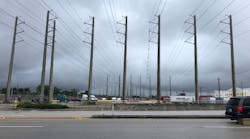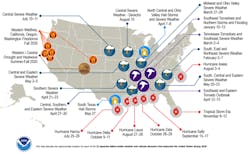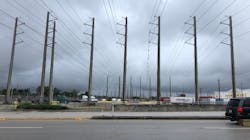Customers without electricity for days or weeks? Does that happen in the U.S. in the 21st century? Increasingly, the answer is yes. Wildfires, hurricanes, ice storms, floods and other events seem to come more frequently and with greater intensity. It is well past time to accept these devasting and life-threatening outcomes and pursue new approaches to resiliency to protect communities from high-impact, low-frequency (HILF) — or black sky hazard — events.
Electricity is fundamental to the health, safety and economic vitality of the U.S. It is the fundamental critical infrastructure that must operate for other critical infrastructure to function. Communications, water purification and distribution, wastewater systems, fuels, transportation, medical services, financial systems and physical security do not function when impacted by HILF events without a resilient electric system.
According to the National Oceanic and Atmospheric Administration (NOAA), the U.S. experienced 22 separate billion-dollar weather and climate disaster events in 2020. Significant and major power outages were associated with these events. The trend did not improve in 2021. The extreme cold weather event in February 2021 from winter storm Uri wreaked havoc on the Midwest. Texas suffered outages and rolling blackouts for days, and the Federal Energy Regulatory Commission (FERC) and North American Electric Reliability Corporation (NERC) launched an investigation into the impacts and causes. Then, in August, massive power outages occurred when Hurricane Ida hit landfall in Louisiana. New Orleans went black for days when all eight transmission lines into the city were damaged from the hurricane winds and debris. The extent of damage from a tornado outbreak across five states and derecho winds from Colorado to Michigan in December is still being determined.
Other notable events in recent years include the 2017 Hurricane Harvey flooding in Houston, Texas, the 2017 Hurricane Maria devastation in Puerto Rico and the U.S. Virgin Islands, the 2018 Bomb Cyclone that caused severe disruption along the East Coast and Canada, the 2018 Camp Fire that was the deadliest and most destructive wildfire in California history, the 2019 Polar Vortex that created a severe cold wave in the Midwestern U.S. and Canada, and the increase in wildfires in the West.
The value of critical electric service and critical infrastructure that electricity supports immediately after these high-impact storms and events is immense. Without some level of survival of the electric system, lives are lost; local commerce, education and medical care grinds to a halt; and personal safety, security and well-being are at perilous risk. The frequency and magnitude of these HILF events are increasing; therefore, improving the resiliency of the electric grid is imperative and will be key to managing an uncertain future of more HILF events.
What Is Resiliency?
Many organizations, including the Electric Power Research Institute (EPRI), NERC and the North American Transmission Forum (NATF), have developed succinct definitions of resiliency in the context of electric infrastructure. In short, resiliency is the ability to reduce the magnitude and duration of extreme disruptive events through prevention and preparedness, response and recovery.
Improving resiliency does not mean building everything bigger and stronger: that may not be the most economical choice or the best use of resources. Improved resiliency should prevent a complete loss or collapse of the electric system by prioritizing the survival of key elements of the electric system that support critical infrastructure, with the remaining electric system able to be more readily and rapidly restored by building off the surviving core. A resilient electric system will provide continuity of service to all areas of critical infrastructure as well as targeted and select areas in the community. There may be some failures or losses, but the failures from HILF events should not lead to a total loss of the system. As a result, a more resilient system can be restored faster, with better triage and restoration time estimates for stakeholders.
A gray line exists between major adverse reliability events and extreme catastrophic resiliency events. NATF collaborated with EPRI, the U.S. Department of Energy (DOE), and the Pacific Northwest National Laboratory (PNNL) to develop a transmission resilience maturity model (TRMM). The model provides a relative perspective of extreme and catastrophic events on the reliability-resiliency continuum spectrum and the key differentiators that define resiliency events. Improvements made to increase reliability performance during HILF events do not necessarily increase resiliency performance. However, improvements made to increase resiliency during HILF events will improve the reliability performance during major adverse reliability events.
As noted previously, an unfortunate trend is these major events are adversely impacting the electric system with increased frequency, affecting larger areas and more people for longer periods of time. Beyond preparing for natural occurrences (for example, extreme storms of all types, earthquakes, volcanoes and tsunamis), utilities need to be prepared for a wide range of HILF resiliency events, including cyberattacks, physical security attacks, sabotage, terrorism, communication failures, geomagnetic and electromagnetic disturbances, and systemic software and technology failures. Developing comprehensive resiliency plans for HILF events is underappreciated but vital. Utilities must do more to strategically plan and enhance the electric grid to survive HILF events and incorporate resiliency as a cornerstone of electric service.
Reimagine Microgrids
How can utilities build a better and more resilient electric grid that serves the community when it is needed most? A new definition of microgrid is a good start. A new microgrid approach to improved resiliency needs to be holistic with strong integration among traditional and renewable generation resources, transmission, distribution and end users. Utilities need to build microgrids strategically that reduce risks and exposures by initiating long-term investments to achieve high levels of resiliency maturity against HILF events for all stakeholders.
Microgrids must be planned, designed and built to provide real resiliency to communities of all sizes. In the past, many have envisioned microgrids as self-sustaining electric islands that can be separated from the grid in times of distress and operate autonomously for extended periods of time, relying on distributed generation sources. However, conceptual microgrids do not achieve economic and environmental objectives; therefore, utilities have not incorporated this approach into their resiliency plans.
Microgrids need to be redefined. They should be reimagined with the development of electric infrastructure that will provide critical electric service to strategic areas throughout a community during times of greatest distress. This includes targeted hardening and strategic undergrounding of the most critical T&D lines and upgrading substations to ensure electric service can be provided to other critical infrastructure and areas designated as critical for continuity of communities.
Imagine a select portion of the grid remaining in service after a wide-area catastrophic event. The surviving partial system would provide service to multiple small portions of communities across a large metro area. Even if homes were out of power, potable water would still be available. Toilets could be flushed and sanitary systems could still function. Mobile phones could still operate and customers could still access news and emergency information. Phone charging stations could be available and a limited number of grocery stores and gas stations could still operate. Community centers could be available for heating and cooling in extreme weather as well as providing food, water and shelter. Reimagined microgrids would survive catastrophic events, remain operational, and provide electric service to multiple small areas (microgrids) of communities across large service territories.
Part of this new approach to incorporate resiliency into the grid is to rethink how the most critical corridors, circuits, stations and equipment are planned, designed, constructed and protected. They should be planned, designed, constructed and protected much the same as black-start generation and cranking paths.
Utilities could prioritize these resiliency paths, circuits, stations or equipment for the different parts of their grid. For resiliency purposes, the portions that should never go down during a HILF event could be designated as “secure and functional.” The next highest level would be those lines and stations that should be restored first. They would be designed and constructed such that they would sustain much less damage and, therefore, could be restored more rapidly than other lines. They could be designated as “prepared for rapid restoration.” Lastly, the other parts of the system could be designated as “standard construction.”
High-quality standards keep utilities focused on average reliability performance and not resiliency. In the past, utilities worked hard to make the electric grid as uniform as possible. This provided consistent training, material inventory, tools, economics and uniformity across the service territory. Standards assume an average life span for normalized events over the depreciation time frame. They do not consider or incorporate HILF events. The typical use of standards blinds utilities from resiliency measures like functional microgrids. In the future, utilities need to optimize the principles of prevent, respond and recover into the planning, design, construction, and operation of a more resilient grid.
Common corridors are big resiliency risks. Utilities evaluate multiple circuits on common structures and multiple circuits in a single right-of-way width from a reliability perspective. Detailed analytical studies are based on deterministic and statistical computations for likelihood of occurrence, loss of load probability and other such approaches. Reliability standards are in place for common corridors; however, they are not evaluated on a HILF event and resilience basis.
Undergrounding just one transmission line in a common corridor could mitigate the losses from several types of HILF events, such as wind and debris from extreme storms, wildfires, flooding, environmental contamination, physical attacks and terrorism.
Build For Resiliency
Building for resiliency is comparable to physical financial risk hedging against a HILF event. As there are no financial instruments that can purchase operational physical infrastructure, especially in the aftermath of a catastrophic HILF event, utilities should invest in physical resiliency as an alternative to spending money purchasing risk damage insurance.
Industry groups such as EPRI, NATF and NERC among others have been advocating for increased resiliency against catastrophic HILF events for more than a decade. However, utilities have many current and near-term pressing requirements:
1. Decarbonizing the grid (clean energy conversion at utility scale, distributed energy resource integration, electric vehicle integration, system improvements to manage variable energy resources, interconnection queue).
2. New load/customers.
3. Reliability and operational flexibility improvements.
4. Customer improvements.
5. Normal operations and maintenance (O&M) and storm-response programs.
6. NERC reliability standards.
The industry needs to undertake a progressive, strategic investment program to harden critical elements of the grid, including strategically undergrounding select T&D lines to ensure continuity of service and quick restoration. Resiliency will include a stronger grid, upgraded substations and newly defined microgrids.
Utility executives and local and state regulators are the initial focal point for ensuring there is a focus on resiliency and plans to achieve it. The boards of utilities should ensure resiliency is addressed in strategic plans and funding initiatives. The business community and community leaders should have conversations with utilities and regulators on the need and value of being prepared for HILF events. Utilities and regulators also need to shift some of the reliability expenditures into resiliency investments. Resiliency improvements usually have the effect of providing benefits to reliability.
Planning, designing and building resiliency improvements like new microgrids along with all the other O&M and capital improvements is a tremendous coordination challenge. Only so much work can be done in any given year. These types of resiliency improvements take time and utilities need to develop 5-, 10- and 20-year plans to achieve resiliency goals.
When considering the costs and benefits of improved resiliency, utilities and regulators must work collaboratively to define the needs for the communities they serve and regulate. Long-term plans need to be developed to achieve high levels of resiliency maturity for HILF events. They must identify permanent funding mechanisms to provide certainty to the plans and improvements. One such option can be the development of a small percentage of overall spending specifically dedicated to microgrid resiliency plans. The value of the resiliency improvements should quantify items not normally captured by traditional cost-benefit analysis:
- Direct cost of losses to homeowners and businesses.
- Negative impact on life and property.
- Immediate and near-term economic impact to the community.
- Long-term impact to the economy
- Negative impact to the social fabric of the community.
The economic and social impacts to communities need to be incorporated into the overall assessment. The total cost of ownership (TCO) over the life of the asset has been neglected by most of the electric utility industry for decades.
Catastrophic HILF events could happen at any time. Utilities always need to be prepared for any type of catastrophic event. A failure to act now means the scenarios that happened in Texas and New Orleans will be repeated many times in the future. There is a lot of complexity and detail to develop a well-conceived resiliency plan that includes reimagined microgrids.
Resiliency improvements to the electric system must be made as cities and communities develop and implement a strategic program of resiliency, so that no metro, urban or rural area is in this situation again.
Start Preparing Now
The value of electric service and the critical infrastructure that electricity supports immediately after these high-impact events is immense. Lives are lost; local commerce, education, and medical care grinds to a halt; and personal safety, security and well-being are at heightened risk when the electricity is off. Electricity is critical to protect the vitality of communities, and that pressure increases with the size and density of a metro area. The challenges for improved resiliency become even greater as electrification of buildings and the transportation sector are considered.
Knowing and having certainty a community is safe, with access to the basics of life, and that help is on the way enables everyone to come together, with neighbors helping neighbors. A well-planned, -designed and -built resilient electric system will provide continuity of service to all areas of critical infrastructure as well as targeted and select areas in the community.
Improved resiliency does not necessarily require everything to be built bigger and stronger. A resilient electric system with microgrids that serve critical loads will not allow a total loss of the system and everything it serves. Improved resiliency maintains service to critical in-frastructure and enables better triage, improved restoration estimates and more rapid responses on the balance of the system.
This new paradigm of planning, design and prudent investment in reimagined microgrids with strategic hardening and undergrounding of lines will prepare utilities for the high-impact storms, wildfires, attacks and other HILF events of the future, while dramatically reducing the negative impacts on life, property, business, the economy and the community social fabric. Now is the time to start.
Mike Beehler P.E., ( [email protected] ), is the national spokesperson for the Power Delivery Intelligence Initiative and the chief opportunity officer for Mike Beehler & Associates LLC. He started his career designing and building transmission lines and substations for Tucson Electric Power and the Hawaiian Electric Co. and then spent more than 20 years designing T&D infrastructure and consulting on emerging trends at Burns & McDonnell. He has written, presented and consulted on reliability-centered maintenance, critical infrastructure protection and program management. In addition, he is a well-known industry writer and speaker on the early definition of the smart grid, 3-D and building information modeling applications in T&D, and development plans for smart cities. Most recently, he is sought for his strategic leadership and vision on the application of emerging technologies in changing business models to include the integration of distributed energy resources, augmented/virtual reality and artificial intelligence. He authored the book, The Science of the Sale. Beehler is a registered professional engineer in Arizona, Florida, Hawaii, Texas, Colorado, Kansas, Georgia and Alabama. He also is a Fellow in the American Society of Civil Engineers and a member of IEEE and CIGRE.
Robert E. Kondziolka,P.E., ([email protected]), has over 40 years of experience in engineering, planning, budgeting, line routing, public involvement, project management, design, construction, real-time operations, maintenance, reliability standards and overall management of electrical transmission systems. Kondziolka is a governing body member of the California ISO Western Energy Imbalance Market (EIM) and currently serves as vice chair. Prior to becoming an independent governing body member on the EIM, he worked at Salt River Project for 36 years. When he retired from Salt River Project, Kondziolka held the position of management consultant for grid resiliency and security. Previous management positions at Salt River Project included director of transmission line design, construction and maintenance, director of power delivery engineering, director of transmission and generation operations, executive manager of transmission planning and development, manager of transmission line design, project engineer for the Mead Phoenix project, and supervisor for transmission line structural and geotechnical engineering. Kondziolka was a senior engineer at Salt River Project and design engineer at Tucson Electric Power, addressing all aspects of transmission line design and development. A registered professional engineer, Kondziolka has been involved in industry organizations, received several awards for research and industry contributions, and authored and coauthored technical articles related to transmission line systems. He has been involved in many of the efforts to achieve a more coordinated and unified Western Interconnection to improve reliability and economics.







